When Do You Learn Long Division
Nosotros've worked with primary maths experts to create a parent's guide to curt division (including the bus end method) and the dreaded long division.
In hither we've explained everything you need to know to help your kid with these tricky topics!
Information technology doesn't matter whether it is short division or long sectionalization, for many children and their parents merely the mere mention of the 'D' piece of work can ship shivers down the spine of many immature mathematicians, but information technology doesn't need to be the example!
Here at Tertiary Infinite Learning nosotros are on a mission to make maths attainable for all, and this includes short division and long sectionalisation too…
In the past, division was taught without much concrete modelling (using concrete items to help represent the maths problem), and so information technology'due south no wonder that many of us parents find information technology hard to this very day.
Nowadays though, with children spending a lot of time at schoolhouse understanding how division works, rather than simply memorising the method, the fearfulness around KS2 division is melting away, but recapping and helping your child to practice division at home will make a big difference
But before you lot find out everything you demand to know well-nigh division for kids, nosotros've prepared a cursory division recap for y'all!
This web log is function of our series of blogs designed for teachers, schools and parents supporting home learning.
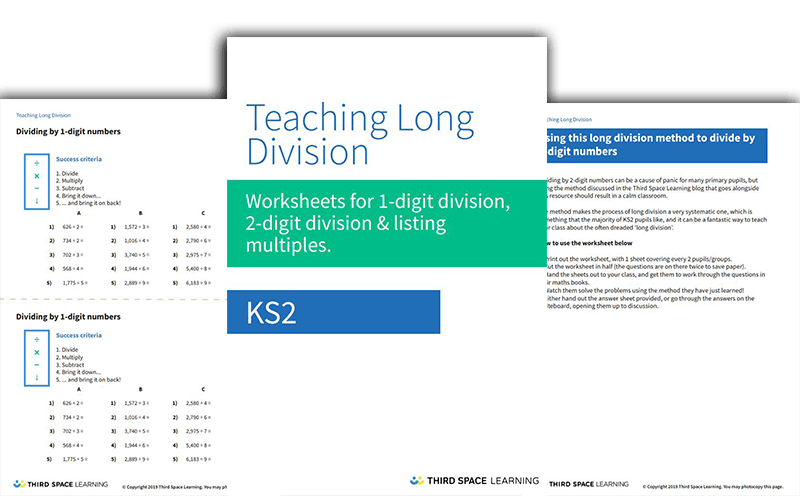
Long Partitioning Worksheets for Years three-vi
This Gratuitous resource contains three ready to apply worksheets for your grade that will help them with all aspects of long partitioning, from 1-digit numbers through to working out multiples!
Partitioning methods in a nutshell
We know how devilishly hard partition can be for both you and your kid, so let's start off with some definitions and a recap of what you lot may accept forgotten since schoolhouse.
What is division in maths?
Partitioning is the performance that is the opposite of multiplication and it involves splitting into equal parts or groups.
In chief school, three methods of sectionalisation are taught, each of which vary in difficulty. They are:
- Chunking
- Brusque division (also known as the bus stop method)
- Long segmentation
What is chunking?
Chunking is a method that is used to split up larger numbers that cannot exist divided mentally.
When using the chunking method, children will repeatedly subtract the divisor from the dividend until in that location is an reply. For example, 12 ÷ 3 would exist solved by doing 12 – 3 to get nine, 9 – 3 to get 6, half-dozen – 3 to get 3, and so 3 – 3 to become to 0.
When all of the times 3 has been subtracted from 12 are counted upwards (4), it becomes clear that the answer is 4.
What is short sectionalisation?
Short sectionalization is a quick and effective method to work out partitioning with larger numbers.
Later on your child becomes comfortable with chunking, they will motility onto curt division as it tin can be used to solve a division problem with a very large dividend past post-obit a series of piece of cake steps.
For instance:
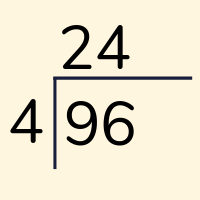
In this example iv goes into nine two times, and it leaves a remainder of one.
This remainder is then passed onto the next number (six) to make it 16. Four goes into 16 four times, so when put together the answer becomes 24.
What is the bus stop method?
The autobus finish method of segmentation is only some other proper name for short segmentation. It gets its name from the idea that the dividend (the number you lot desire to divide upwards) is sitting inside the passenger vehicle stop while the divisor waits outside.
Teachers are divided most whether this is actually a useful image when learning division so most of the time we're just going to refer to it as brusk sectionalisation.
What is long partitioning?
Long division is a method that is used when dividing a large number (unremarkably iii digits or more than) by a ii digit (or larger) number. It is gear up out in a similar way to the passenger vehicle stop method that is used for short division.
Accept a look at out example beneath to see long division explained in a visual example.
It is all-time explained through an example – see below.
We have a very detailed article written for teachers on this subject area you might relish if you lot want to go into more depth about teaching the long division method at KS2.
Terminology yous need to know when teaching division
In our parent blogs we endeavour to avert as well much jargon, merely the post-obit iii terms really are essential to know for anyone looking at sectionalisation.
- The dividend is the number you are dividing (the number inside the 'bus stop'
- The divisor is the number you are dividing by.
- The caliber is the amount each divisor receives ie the reply in virtually cases.
A good way to call back it is dividend÷ divisor = caliber
Parts of a segmentation problem labelled for kids and parents
By learning the correct vocabulary of all the parts of a division problem, your child will find lots of elements of division much simpler.
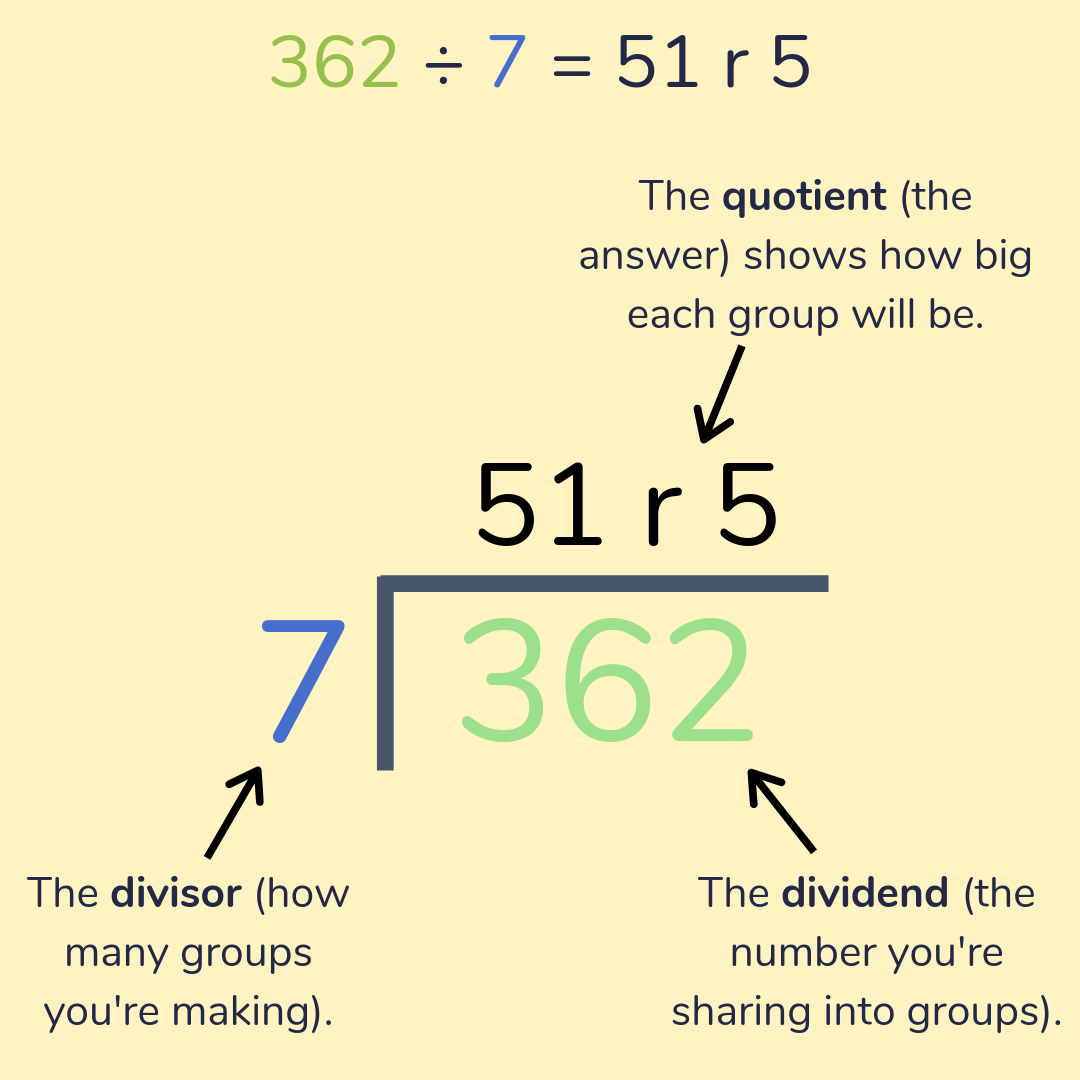
What does my child need to know about short division and long division in KS1 and KS2?
With curt division and long division for kids changing from year to year throughout primary schoolhouse, there is a lot to cover in the blog, but to help yous out we've broken it downward on a twelvemonth by year basis.
Division Twelvemonth ane: how you lot can aid
In Twelvemonth 1, division is usually called sharing and it's done using concrete items like counters, blocks, or even items of food such every bit pasta.
This helps children to understand partitioning as sharing between groups.
A unproblematic example of this can exist plant below.
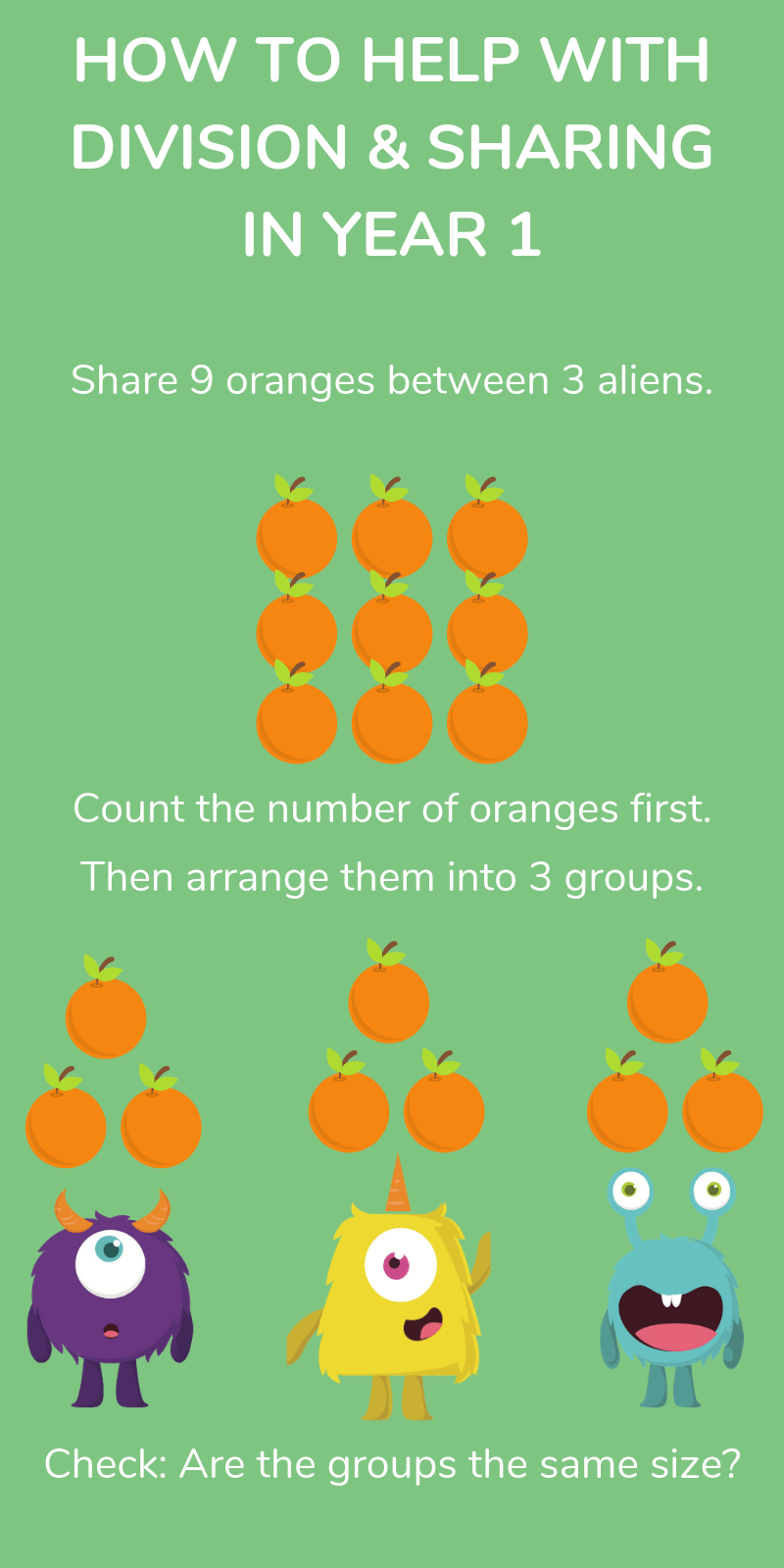
Some elementary Year one partition discussion problems
Grab a fix of blocks and help your kid try to figure out these segmentation problems.
Make sure that yous call back to utilize words like share and carve up throughout so that your child becomes familiar with the concepts.
Start with 4 blocks. Share them into 2 equally sized groups.
Starting time with 10 blocks. Share them into 2 equally sized groups.
Start with six blocks. Share them into 3 equally sized groups.
Sectionalization Year 2: how you tin can assist
In Year 2, children commencement to look at the way sectionalization works more deeply, and this means that there are a few more things for your child to acquire.
A central concept to understand and really get to grips with at this historic period is commutativity .
If you are struggling to remember exactly what commutativity means, the definition is simple.
In maths, the commutative belongings states that club does not affair.
Multiplication is commutative ; you can switch around the numbers and it makes no difference.
2 ten 3 = 6
3 x 2 = 6
Division is non commutative . If you lot switch the order of the numbers, it changes the respond.
4 ÷ 2 = 2
two ÷ iv = 0.v
Partitioning and commutativity in Year 2
At this age, it'south good to exercise learning the 2, v, and 10 times tables with their respective division facts. For example:
Multiplication fact:
2 x v = 10
Respective division facts:
10 ÷ 5 = 2
10 ÷ 2 = five
Knowing these facts makes division much easier afterwards on, and they are a great example of why commutativity is important.
If your child is comfortable with the difference between 10 ÷ five and 10 ÷ 2 fifty-fifty afterward seeing that v x 2 is the same as two x 5, they will be best placed to motion comfortably upward to KS2 short division, and KS2 long division.
Division Year 3: how you tin can help
In Twelvemonth 3, your child volition exist focusing on writing down sectionalisation calculations and solving unproblematic sectionalisation problems that involve missing numbers.
Knowing multiplication and division facts comes in really handy here, so as was the instance in Year 2, it is very important that you practice these with your child.
This missing number trouble volition help y'all see why times table knowledge makes division much easier:
5 10 4 = 20
__ ÷ 5 = 4
twenty ÷ __ = 5
There are besides two written segmentation methods that are introduced at this age, and they are broken down below.
Written methods of division for kids
The chunking method of division explained
Although this method is a flake slower than bus end sectionalisation, it's great for developing the mental skills children need for more complex division afterward downwards the line.
How to practise the chunking method of division
Chunking is when y'all work out how many times a number fits into another number.
Y'all work it out by repeatedly subtracting the divisor (or multiples of the divisor) until you get to zero to see how many times the divisor tin can go into the number yous're dividing (the dividend).
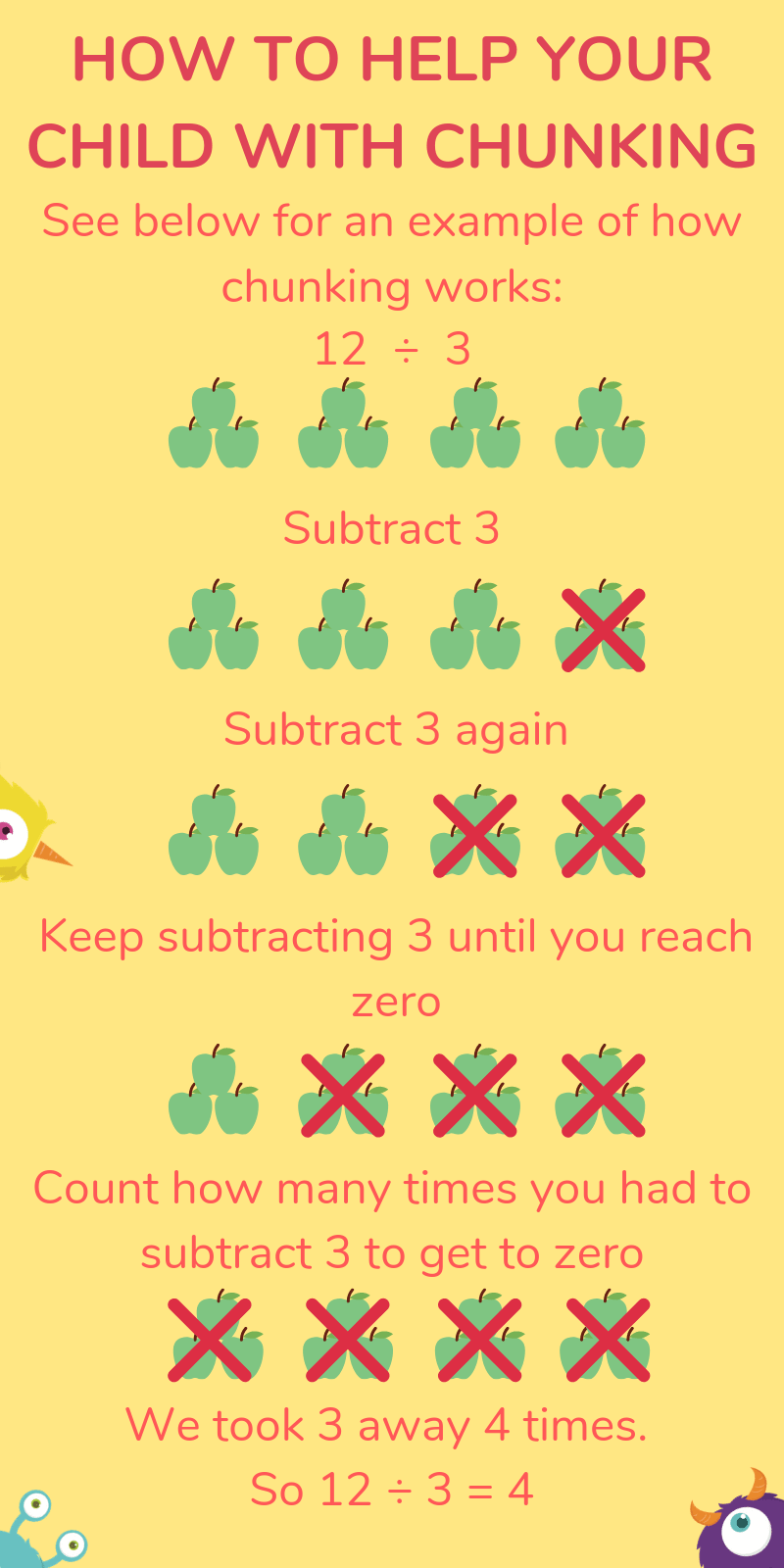
Chunking is a skillful way to introduce your kid to some of the more basic concepts of segmentation, and once they have come to terms with this they can and so move onto the short method of division.
The short sectionalisation method or bus stop method of division explained
Oftentimes referred to as the coach end method due to the fact that when drawn out onto a slice of paper, the adding shares some visual similarities to a charabanc cease, this KS2 short division method is 1 of the about popular methods taught in schools.
This method is quicker than chunking, but it'due south important that children sympathize what they're doing (instead of just following a method).
This will make long sectionalization much easier in the future, but it is advisable to make certain your child has nailed chunking before moving on to curt division.
How to do short division
Short division at this historic period will involve single digit divisors and 3 or 4 digit dividends.
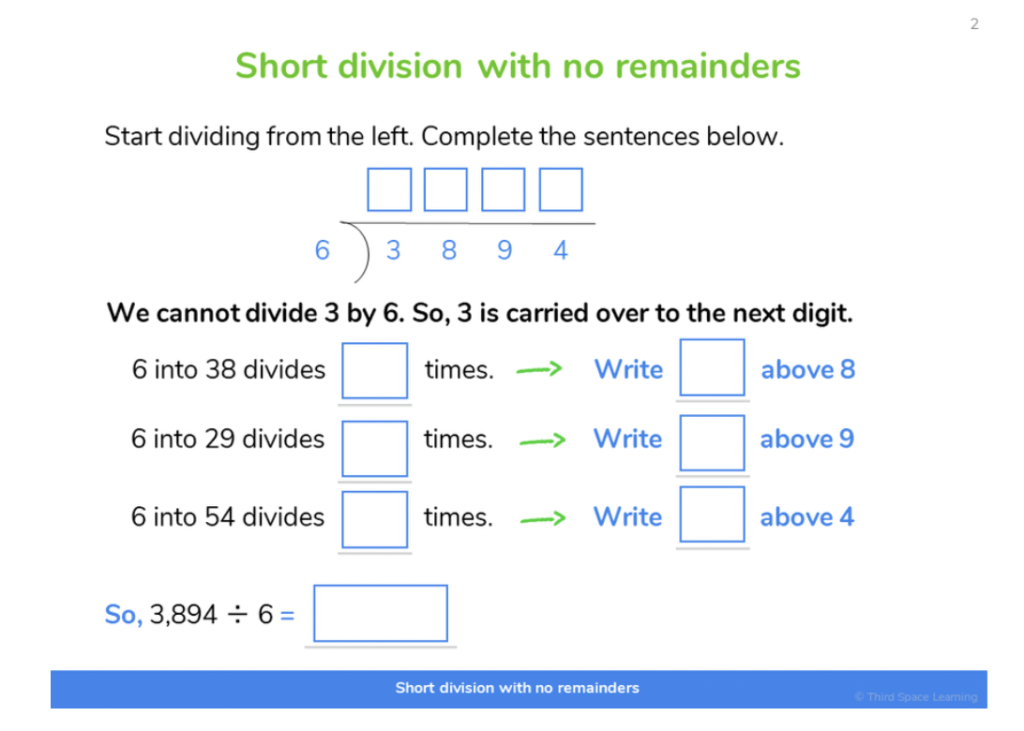
Sit down with your child and take a look at the diagram below to get to know the names and places for each part of the division trouble.
They can look very unfamiliar when you're used to writing your sums out in a line, then work with your child to ensure they know their divisor from their dividend!
How to help your kid divide a three or four digit number by a single digit number
With these types of segmentation questions forming the majority of the one's your kid will be tackling in Year 3, hither'due south a graphic detailing how to divide a three or four digit number by a unmarried digit number.
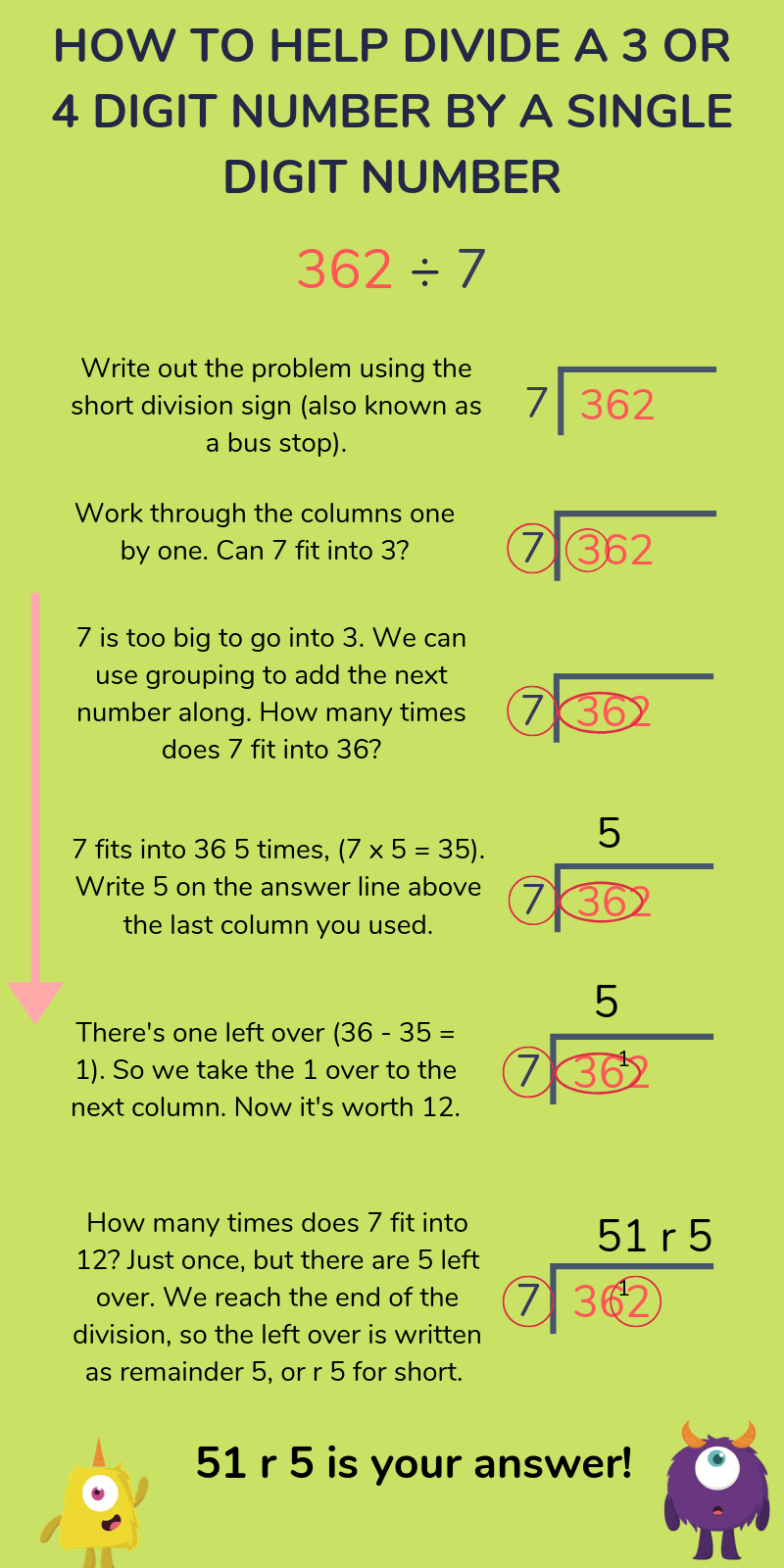
Division Year 4: how you can help
In Year 4, your child will use short division (the jitney stop division method discussed above) to divide numbers up to 4 digits by ii-digit numbers.
The method is exactly the same every bit with single digits, wait the offset step volition always involve grouping.
By this stage the process of dividing becomes much more than of a struggle if you child doesn't take their multiplication tables by center so one of the best things y'all tin can practise for them is support the learning of these.
They'll likewise need to choose what kind of remainder to use depending on the question, and some common questions will involve real-life situations, like sharing groups betwixt cars or items between boxes.
Partition questions with remainders
Remainders can be a tricky concept to grasp when children are offset introduced to both short and long division, but it is of import they your child understands them well as they can drastically change depending on the question that is being asked.
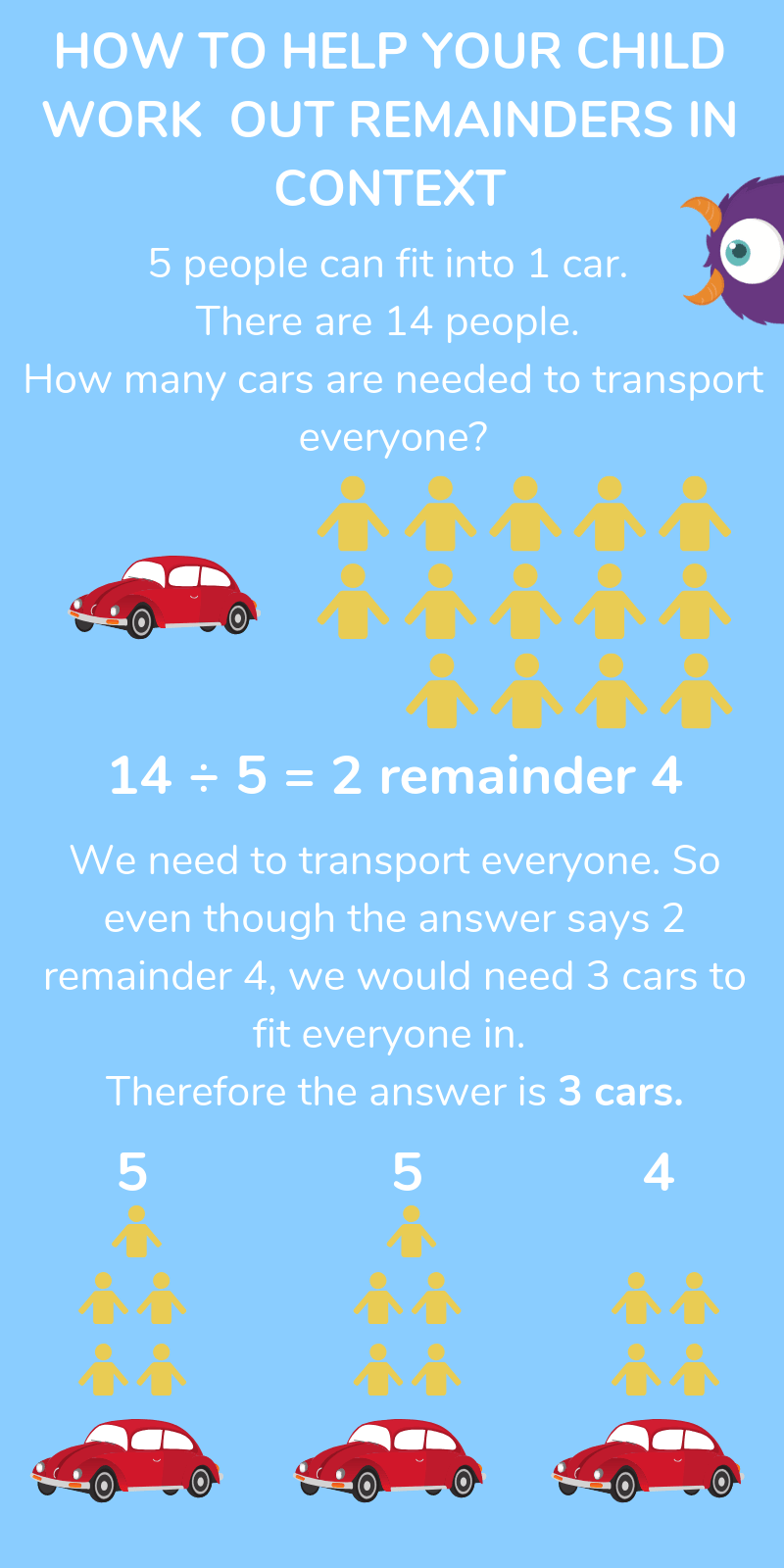
Exercise using cistron pairs in Year 4 to help with written partitioning
Factor pairs are 2 factors (numbers), which when multiplied together give a item production (issue).
Practising cistron pairs with your kid can help to speed up the process when information technology comes to partitioning, as knowing that iv x 5 = 20 will aid them when it comes to working out xx ÷ 4 = _ .
Get your kid to find every bit many factors pairs as they tin can for the number beneath, and why not make this into a game?
Sit down down with your child, grab a pen and a slice of newspaper each, and see who can figure out the most gene pairs for the post-obit numbers in a minute. The results might be closer than yous think!
- 20
- 68
- 12
- xxx
- 100
Read more: What is the highest common factor
Sectionalisation Year v: how you tin can help
By Year 5, your child should exist able to quickly halve or quarter amounts mentally.
If they're finding it tough, bringing maths into the real world can be a corking way to help them get to grips with halves and quarters. For example, when yous're out and virtually ask them how much an item would be if it were half off, or how many grammes would be in half of a 1kg bag of carbohydrate.
Knowing how to divide by two (halving) and 4 (quartering) chop-chop will become an important part of division as your child progresses through school, so it is highly benign if they can learn these at present.
Brusk division with decimals
Brusk division will exist used for numbers involving decimals for the showtime time in Year v.
This means that it is a good time to revise place value so that your child understands how decimals work.
Decimals are parts of a whole (like to fractions), but the important affair to remember when it comes to dividing decimals is that identify value columns decrease in value each time y'all move to the right.
An case of dividing with decimals
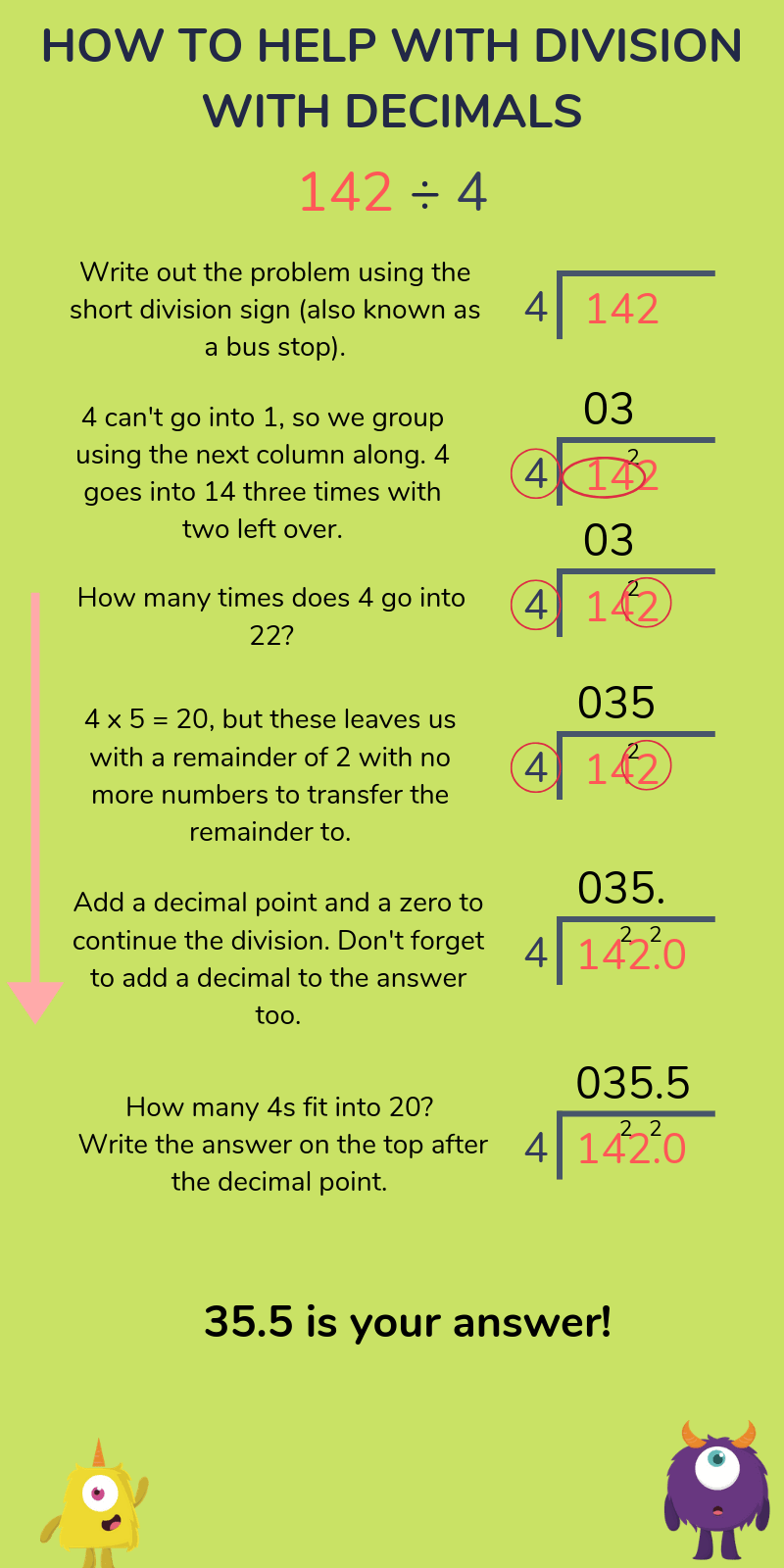
Segmentation Year 6: how you tin can assistance
In Yr 6 your child will exist introduced to the dreaded long sectionalization for the first time!
However, the good news is that one time yous've mastered chunking and short division, long partition isn't bad at all!
The key when it comes to long partitioning for kids is to get slow and encourage them to present their piece of work neatly then that they can spot mistakes easily and work to rectify them.
Fifty-fifty when knowing this though, long sectionalization can still be a daunting prospect for children (and parents akin!), so accept a look at our example below to get to grips with how to tackle a long division problem.
Long division for kids explained
The instance below is the most popular long division method for kids, and information technology is also the i that you lot may be familiar with from your fourth dimension in primary school.
All you'll need to complete the adding 528 ÷ 24 is a pen, some newspaper and a kid who is willing to go to grips with this method!
After having a become at a few long division questions (with your assistance to begin with), your child will shortly see that this method tin help them effigy out how to work out long partition problems regardless of the numbers involved, and bear witness invaluable when it comes to the SATs.
How to practise long division: An like shooting fish in a barrel footstep by step long division method to utilize throughout KS2
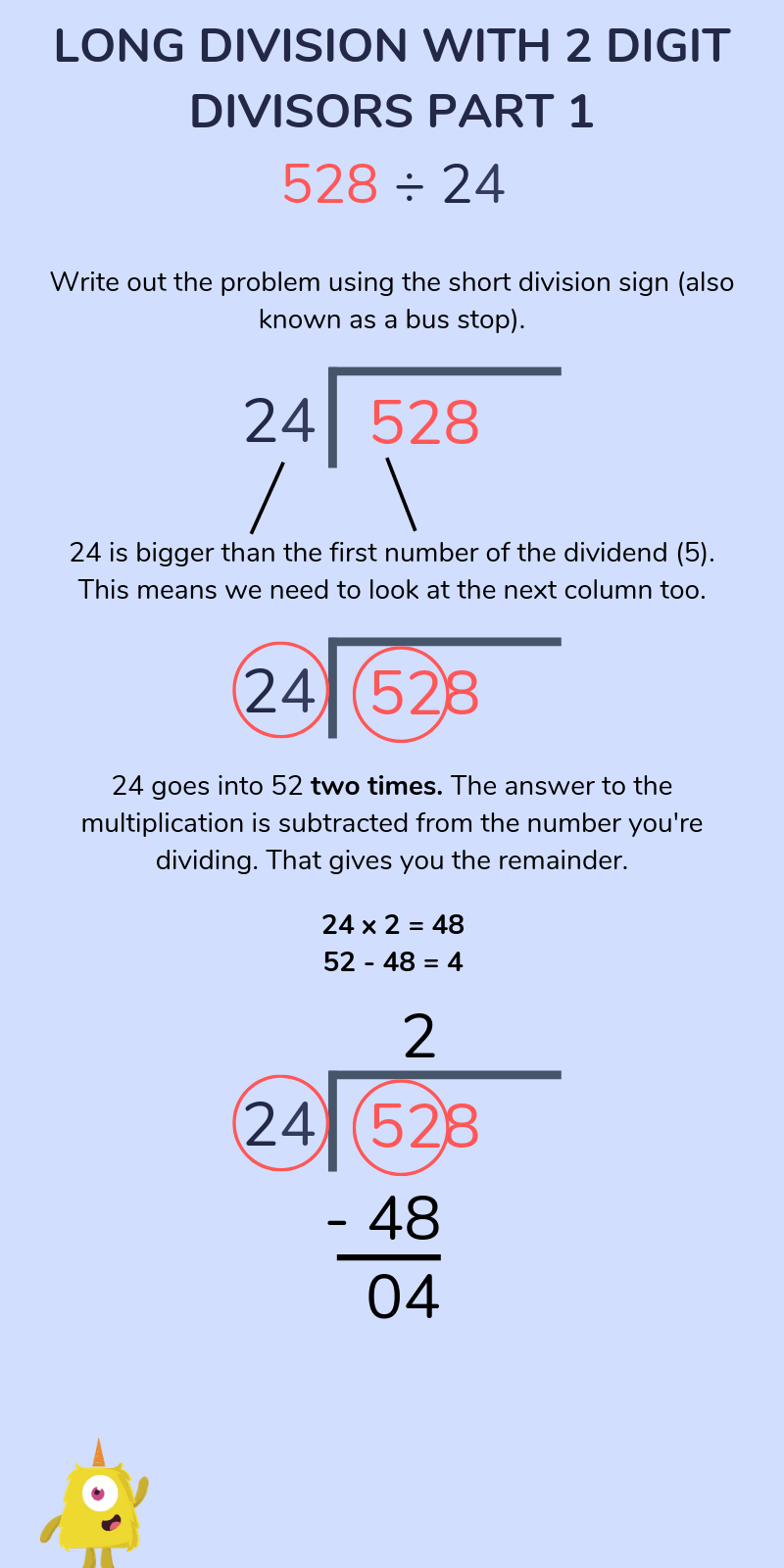
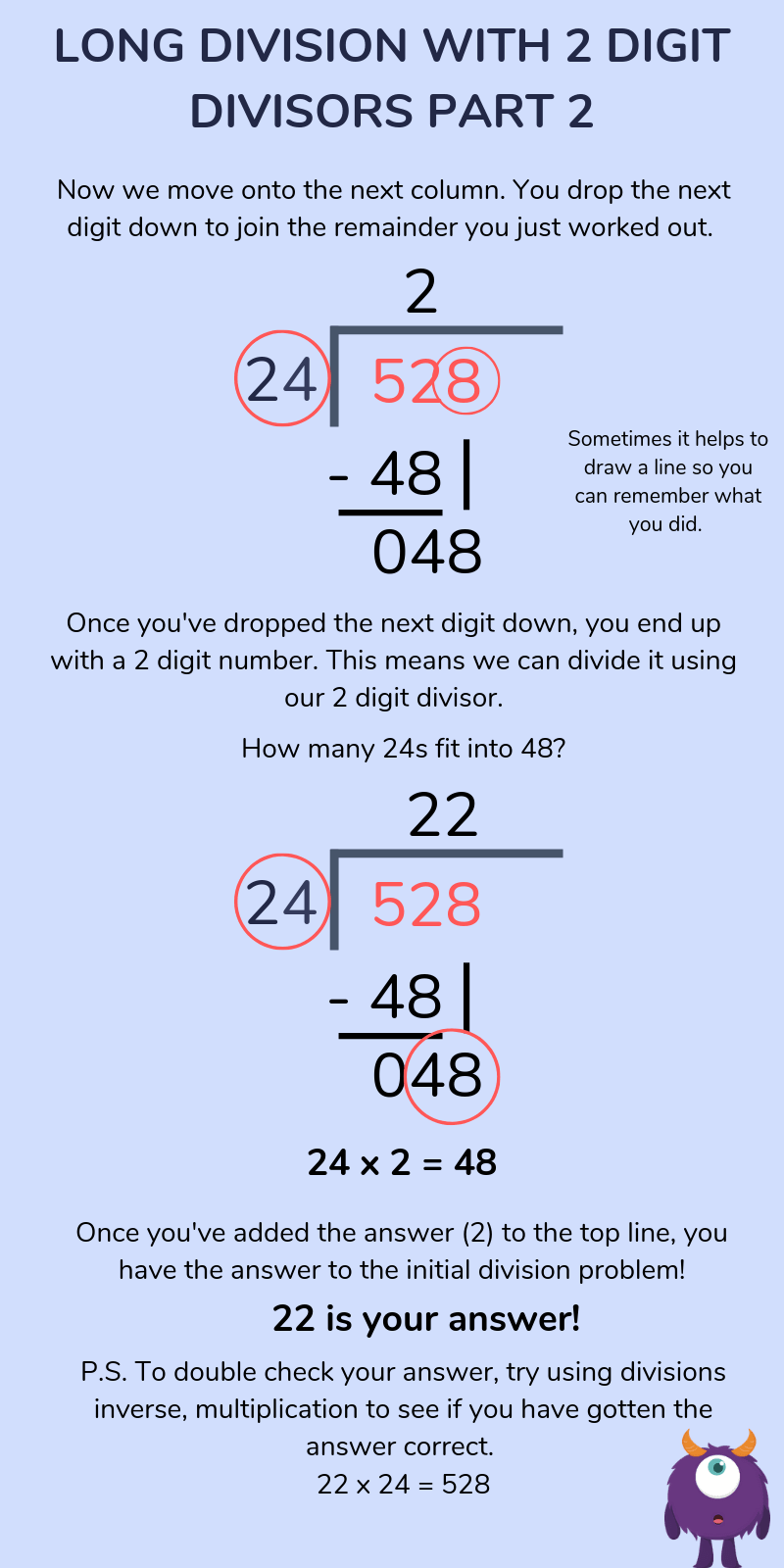
Don't worry if it takes a while to truly embed the process. Information technology's a long chain of things to remember, so information technology'll take regular practise to get this method memorised.
Just recall the process: divide, multiply, subtract, bring down; and repeat.
Hard work will pay off in the long run, and so it is worth putting the time in with your kid now to brand sure long division is explained well early to lessen the number of times you volition hear the inevitable:
" Mummmmm…….How practise yous do long division…?"
How practise we know when to divide and which method to employ?
Different partition questions call for dissimilar methods of sectionalisation to solve them, but hither is a quick and easy guide to show which method your child should use and when:
- Chunking is best for smaller numbers and arithmetic.
- Short division is great for dividing larger numbers by i digit numbers.
- Long division is handy for dividing large numbers past numbers with 2 or more digits.
Of class there may be occasions when each of the above methods tin can be used in slightly different scenarios, but as a general rule this should be enough to help your child make the right decision.
Year 6 SATs division questions
When it comes time to sit down the maths SATs papers it is more than likely that your kid will have to respond some segmentation based questions.
Problem solving and reasoning (Newspaper 2 and 3) in Twelvemonth vi tin can be tricky when information technology comes to division problems. Oftentimes, the problems require more ane operation to be solved which can add an element of complication into an already stressful surround, so encourage your child to wait out for words like share or grouping to help them place what needs to be done to solve the trouble.
Sectionalization bug in Paper 1 (arithmetics) will be presented as number sentences, and your kid volition demand to show their working out if the question is worth more than ane marking.
Information technology'due south like shooting fish in a barrel to spot these questions because they will use the division symbols, either:
÷
or

or they may involve fractions.
Every bit a rule of thumb, encourage your child to divide mentally where possible.
While written methods are great for bigger numbers, being able to carve up mentally will requite them an edge. It means that when they are done using the written method, they will be able to run across whether or not their answer is roughly right by estimating.
As well equally the free long division worksheets yous can also download a gear up of free SATs questions on division and multiplication to extend your practice.
That should have covered everything y'all demand to know well-nigh partitioning for kids. If you lot're peachy for more than ways to help with maths homework, then we recommend you lot likewise take a wait at the following 'parent and child explainer' guides too.
- Fractions for Kids: How to Assistance at Home
- How To Larn Times Tables at Abode
- Give-and-take Problems Explained with Examples
Online one-to-i maths lessons trusted by schools and teachers
Every week Tertiary Infinite Learning's maths specialist tutors support thousands of primary school children with weekly online 1-to-ane lessons and maths interventions. Since 2013 nosotros've helped over 100,000 children get more confident, able mathematicians. Learn more or request a personalised quote to speak to united states of america nigh your needs and how we can help.
Maths tuition for 5 to 12-year-olds focused on the national curriculum and delivered online
Source: https://thirdspacelearning.com/blog/guide-division-for-kids-explained/
Posted by: gillhamboyaceing.blogspot.com


0 Response to "When Do You Learn Long Division"
Post a Comment